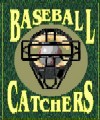 |
|
 |
|
Using Different Parts of the Strike Zone
(Getting the Batter To Hit To The Fielder Of Your Choice)
If your battery mate, the pitcher, has reasonably good control and a decent curve and a fastball, you can get the batter out most of the time by using different parts of the strike zone, especially if your infield is good at groundball outs.
A lot of players have the perception that the upper outside area in the strike zone is a hitter's zone, because a hitter can get good arm extension as well as a good look at the ball. What actually happens is that a pitch in the up and out zone is easily hit IF it isn't the pitcher's pitch. Often it is not because hanging curves and slightly overthrown fastballs have a tendency to go there. However, if the pitcher throws a good tailing or sailing fastball in that zone, most hitters will hit a lazy fly ball (fair or foul) or a pop-up to the opposite field most of the time. The conventional places to throw a curve are down and away, which is very good, or up and in (the Don Drysdale mode). Mostly you're looking for a called strike when your pitcher throws it up and in because you want to fool the hitter and have him taking a pitch. Whereas, when you call down and away or down and in, you don't care if the batter knows it's a curve ball because it's your pitcher's pitch. It's a strike and usually he's not going to hit it hard even if he does get his bat on it. The key to using the strike zone, in getting batters to hit the ball where you want it, is a confident and capable battery. If both the pitcher and the catcher are confident that a ball thrown to a specific part of the strike zone will produce positive results, then they will. Catchers must set good targets using every inch of the zone. Pitchers will develop better control over time if the catcher works with the pitcher to use the full arsenal possible. No pitcher will improve control and increase capability if the catcher constantly calls for pitches right down the middle just because the catcher feels that the pitcher doesn't have good enough control to hit the corners. Lastly, by not routinely working the upper outside and the upper inside of the strike zone to build confidence and capability, the pitcher might develop fear of the red diamond and start bouncing every other pitch in the dirt. In summary, a reasonably confident and capable battery can get the batter out most of the time by controlling where the ball will go or not go. It's not very hard to figure out where a pitch ought to be. Just look to see how the batter sets himself. Not many batters are cagy enough to hide either what they are protecting against or what they're hoping to see. Remember, 60% of the zone belongs to the battery so call the pitch 99.9% of the time to your strength.
|
